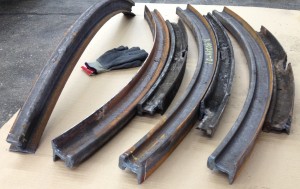All modern rails are made out of hot rolled steel with a specific profiled cross section that includes the head, web and foot. The head is profiled to resist wear and to give a good ride, and the foot is profiled to suit the fixing system. Rail profile resembles an I-beam but is asymmetrical about the horizontal axis. Tee Rail was first manufactured in the United States in 1845. Crane rails did not become available until the turn of the century. Both rails can be used in a crane runway system. Crane rails were specifically designed to carry very heavy loads at relatively slow speeds. Crane rails can be supplied control-cooled, end-hardened or heat-treated. Tee rail sections are used in top running crane applications and automatic retrieval systems. Tee rails come as A.S.C.E. (American Society of Civil Engineers) and are used primarily for light overhead cranes, mining track, automated warehouse retrieval systems, and other industrial applications. A.R.E.A. (American Railway Engineering Association) rails are primarily designed for railroad tracks, including sidings and spur tracks.
Recently we had an industrial machine shop contact us with a request to roll some ASCE25# Rail ball in and ball out to sample pieces he would send to us. The machine shop was contacted by Groot (commercial waste management/recycling services center) who had one of their transportation rails moving the scrap products being recycled go down. The machine shop that had to fix and re-install the new rails did not have enough time to make fabrication drawings for the replacement parts, so they asked if we could curve straight rail to the replacement rails he had removed. This was not very difficult and very common for a rolling/curving company to make. This type of request is very common and fairly easy to do. The advantage is very quick turn around and also the satisfaction of knowing that the new parts will match up perfectly, because the rolling operator will actually use the old curved pieces as templates.








